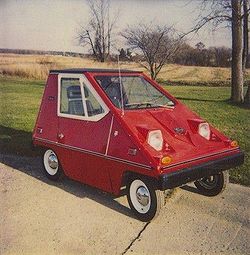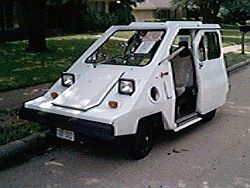- Citicar
-
CitiCar 
Manufacturer Sebring-Vanguard Also called Comuta-Car, Comuta-Van Production 1974 to 1977 Successor Comuta-Car and variants 1979 - 1982 Class Battery Electric Body style 2-door 2-seat Engine GE Series DC motor; 2.5 HP (early), 3.5 HP, or 6 HP (late)
Battery type: 6 X 6v or 8 X 6v lead-acidLength 2,437 mm (95.9 in) Width 1,397 mm (55.0 in) Height 1,524 mm (60.0 in) Curb weight 591 kg (1,303 lb) Designer Robert G. Beaumont, President The CitiCar was produced between 1974 and 1977 by a U.S. company called Sebring-Vanguard, Inc., based in Sebring, Florida. The CitiCar and variants are the most produced electric car in American automobile history. Sebring-Vanguard was sold to Commuter Vehicles, Inc., which produced similar vehicles (the Comuta-Car and Comuta-Van) from 1979 to 1982.
Contents
History
Inspired by Club Car's golf cart design and partly in response to the 1970s fuel crisis, a company called Sebring-Vanguard produced their first Electric Vehicle, the Vanguard Coupe (sometimes referred to as the EV Coupe) in 1974. Company founder and President Robert G. Beaumont,[1] working with designer Jim Muir, came up with the CitiCar after this earlier EV Coupe was not an immediate success. This 2nd attempt was still based on a lot of the Club Car's mechanical features, though.
Produced in their Sebring Florida Plant the CitiCar was a small Wedge shaped electric vehicle. Early versions had no extra features and can be considered an experiment in minimalist automotive design; it was as basic a people mover as you could get at the time. By 1976, enough CitiCars were produced to promote Sebring-Vanguard to the position of being the U.S. #6 auto manufacturer after GM, Ford, Chrysler, AMC, and Checker Motors Corporation; but ahead of Excalibur and Avanti Motors. Production of the CitiCar continued until 1977 with about 2,300 CitiCars produced.
Commuter Vehicles, Inc. purchased the CitiCar design, and renamed the vehicle Comuta-Car. Production of this upgraded version began in 1979 and Commuter Vehicles, Inc. produced an estimated 2,144 Comuta-Cars and Vans. At about 4,444 total C-Cars in all its variants produced it still holds the record for most road-legal Post War electric cars made in the United States.
Models
- The CitiCar came in three models. The original Coupé was the smallest of the three. It had a flat diagonal front, a flat roof, and a flat nearly vertical back. Early coupes, designated as model SV-36, had a 2.5 HP motor and 36v battery pack. The second model coupes, designated as model SV-48, had a 3.5 HP motor and 48v battery pack, and numerous small improvements. During the last year of production, the third model variant of the Citicar, sometimes referred to as Model A, had an improved drive train with a 6 HP motor, and the body was changed slightly to incorporate heater inlet vents on the side of the vehicle and permanently mounted side windows.
- The later Comuta-Car, produced by Commuter Vehicles, Inc. retained the larger 6 HP motor and drive train arrangement, and moved the batteries from under the seat to the bumpers, making the vehicle about 16 inches (410 mm) longer than the 8-foot (2.4 m) long CitiCar.
- The CitiVan, was a limited production extended-wheelbase version of the third model variant of the CitiCar. Produced and sold from 1976 (by Sebring-Vanguard) to 1979 (by Commuter Vehicles, Inc.), it is rummored that only 11 to 19 of these smaller Vans were built. The main design differences between the CitiVan and the later Comuta-Van is that the CitiVan has swing out side doors and a hatch back window. The much larger Comuta-Van has sliding side doors and a swing out rear entrance door.
- Another CitiCar variant was called the Comuta-Van. The overall length was increased to 142 inches (3,600 mm), and it had a 12 HP motor, 72v battery pack, and 3-speed transmission. It still held two passengers, but also had room for storage. It was the only model with a trunk area and sliding side doors. All Comuta-Vans were built with right-hand-drive originally for the US Postal Service by Commuter Vehicles, Inc. The Van pictured to the right is the larger Comuta-Van.
All vehicles were built with space frames made from welded aluminum tube and ABS plastic bodies, with solid axles and leaf spring suspension front and rear. Top speeds were about 30 mph (48 km/h) - 50 mph (80 km/h), and range was up to 40 miles (64 km) per charge.
Specifications
The second model of the CitiCar (SV-48):
- Length: 95 in (2,413 mm)
- Width: 55 in (1,397 mm)
- Wheelbase: 63 in (1,600 mm)
- Height: 58 in (1,473 mm)
- Front Track: 43 in (1,092 mm)
- Rear Track: 44 in (1,118 mm)
- Clearance: 5.5 in (140 mm)
- Weight: 1,250 lb (570 kg)
- Rear Storage: 12 cu ft (340 L)
- Tires: 4.80 x 12, 4 ply rated or optional 135R12 radials
- Speed: 38 mph (61 km/h)
- Range: up to 50 mi (80 km).
- Acceleration: 0 to 25 in 6.2 seconds
- Turning Circle: 22'
- Controller: Vangaurd Multivoltage Speed Control. Three step contactor control system. First - about 10 MPH, second - about 20 MPH, third - about 38 MPH.
- Motor: Series wound DC 3.5 HP
- Transaxle: Direct Gear Drive - Terrell 7.125:1 reduction ratio
- Suspension: leaf springs, front and rear. four wheel shock absorbers
- Body: Impact Resistant Cycolac (ABS) Corrosion and Rust proof
- Frame: Rectangular aluminum chassis, tubular aluminum body support
- Brakes: four wheel - front disk. rear drum - parking. Later SV-48 models had 4-wheel drum brakes.
- Power Source: eight 6-volt flooded lead-acid batteries
History of Upgrades and Changes to the CitiCar by Serial Number
(Note - This is a compilation of CitiCar factory changes from 1974 to 1977; with some Comuta-Car information added. The information is gisted from the owners and service manuals, and the CitiCar Roster.)
Prior to car #1501, CitiCars left the factory as 36 volt models; most had a 2.5 hp Baldor motor, but a few had the 3.5 hp GE motor.
In December 1974, CitiCar number #1501 (124SR1501) was the first factory-built 48 volt CitiCar. These vehicles were designated as model SV-48, compared to the earlier SV-36. All CitiCars made after this vehicle were produced as 48 volt models with the newer 3.5 hp GE series motor.
(Note - A number of the earlier SV-36 models were returned to the factory or to dealerships in order to upgrade to the 48 volt system.)
CitiCar #1751 (March 1975) saw a number of changes to the assembly line. Here is a list of changes at car #1751 –
- Dual master cylinder (was non-redundant single cylinder).
- Electric defroster. On earlier cars, the defroster -switch- was installed per federal regulations but not wired to anything. A 'defogger' element was made available as a dealer option sometime in late 1974 and was normally connected to the otherwise inoperative defroster switch.
- A self canceling Lucas turn signal actuator was installed. In previous vehicles it was a Signal Stat 900 non-self canceling type.
The turn signal switch change required a number of other changes –
- Turn signal mounted high beam switch (was a floor mounted high beam switch).
- Horn voltage decreased to 12v (put back to 18v at car 2584).
- Horn switch moved to Lucas signal lever (was on center of steering wheel).
In addition, there were a number of technical improvements –
- To improve ground reliability, the controller was grounded to the chassis at the right rear wheel well.
- Dash switch for wipers replaced by one with improved quality.
- Chassis ground wire: a larger diameter wire was installed. The previous wire was too small (16ga) and would melt during battery charge.
- Hot lamp wire color changed to yellow (was green).
After the changes at car #1751, there was a minor glitch noted in the service manual. Since a lamp was removed from the instrument panel, there were fewer lamps, and the dimmer would not allow the lamps to go all the way off.
Before car #2011 (May 1975), the CitiCar had front disc brakes. Cars #2011 and after had drum brakes.
On car #2080 (May 1975), the parking brake micro switch was moved to a different position, and was actuated by a plastic collar instead of a detent on the parking brake shaft.
On car #2211 (July 1975), a switch was added to the dual master cylinder along with a small PC board behind the dash to warn of problems with brake hydraulics, as well as indicating if the parking brake is engaged. Before #2211, the brake lamp was a parking brake engaged indicator only.
Prior to car #2426 (September 1975) the accelerator was returned to off via a single accelerator spring. Sebring-Vanguard issued a Service Note to modify all previous vehicles to add another spring. After #2426, a dual spring accelerator pedal was standard.
Around December 1975 there was another major change in the CitiCar assembly line. All CitiCars #2781 and higher were equipped with a 5.17:1 ratio Dana/Spicer rear axle and a 6hp GE motor. There was an optional 'hilly' Dana/Spicer axle with a higher ratio also available for these cars which allowed better hill climbing performance, but at the cost of a slightly lower top speed.
Additional changes with car #2781 -
- Heater vents on side of car.
- 7" rear brake drums (now same as front).
- Factory heat was standard on Dana axle vehicles.
- The defroster switch was moved from the dashboard to the heater panel mounted below the dashboard. The heater panel contained 2 knobs and 1 switch. Prior to vehicle #2781, heat was a dealer-installed option, and used a two-knob panel.
On car #2842 (December 1975), a micro switch was added to the foot brake to prevent the accelerator from functioning when the brake was pressed.
On car #2854 (December 1975), the horn voltage was increased back to 18v.
After June 1976, a number of CitiCars were produced with a different VIN arrangement that ended with an 'A'. These vehicles had similar features to the vehicles produced after #2781, but are sometimes referred to as 'Model A' or Transitional CitiCars.
Although production of the CitiCar stopped in 1977, and production of the Comuta-Car stopped in 1982, a Service Bulletin was issued in September 1984 to change the 3-speed contactor setup for a solid state controller.
There are some indications that after January 1982, a few Comuta-Cars may have been sold as home assembly kits to be registered as Home Built EV’s in the buyer’s state.
References
- ^ Bunkley, Nick (30 October 2011) Bob Beaumont, Who Popularized Electric Cars, Dies at 79, The New York Times
- Robert G. Beaumont Designer of the Citicar
- The Lost Cord by Barbara Taylor Published 1995. ISBN-13: 9781570742958 ISBN-10: 1570742952
- Dina Beaumont
- Robert Rice
External links
- EV Album - Citicar Photos
- http://www.evperformance.com
- http://john.redmood.com/citicar.html
- The Citicar in Didik Vehicles
- http://www.m-cad.com/dp/ev/c-carupg.htm
- http://www.econogics.com/ev/citicar.htm
- http://www.bjharding.com/citicar/moreev.htm
- http://sloan.stanford.edu/EVonline/letton.htm
- http://www.exteriorangle.com/ross/citicar.html
- http://rci.rutgers.edu/~crisitel/EV/C-Car_Roster-Beta.xls
Categories:- Electric cars
- Motor vehicle manufacturers of the United States
Wikimedia Foundation. 2010.


